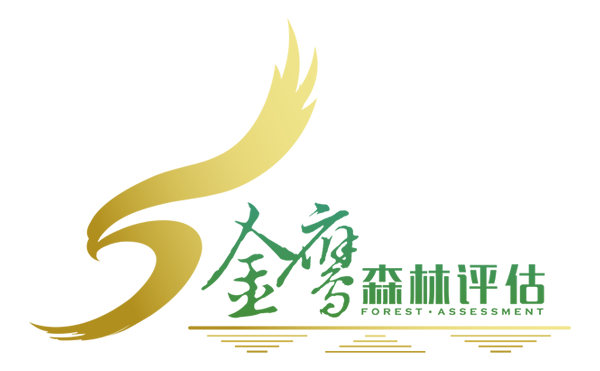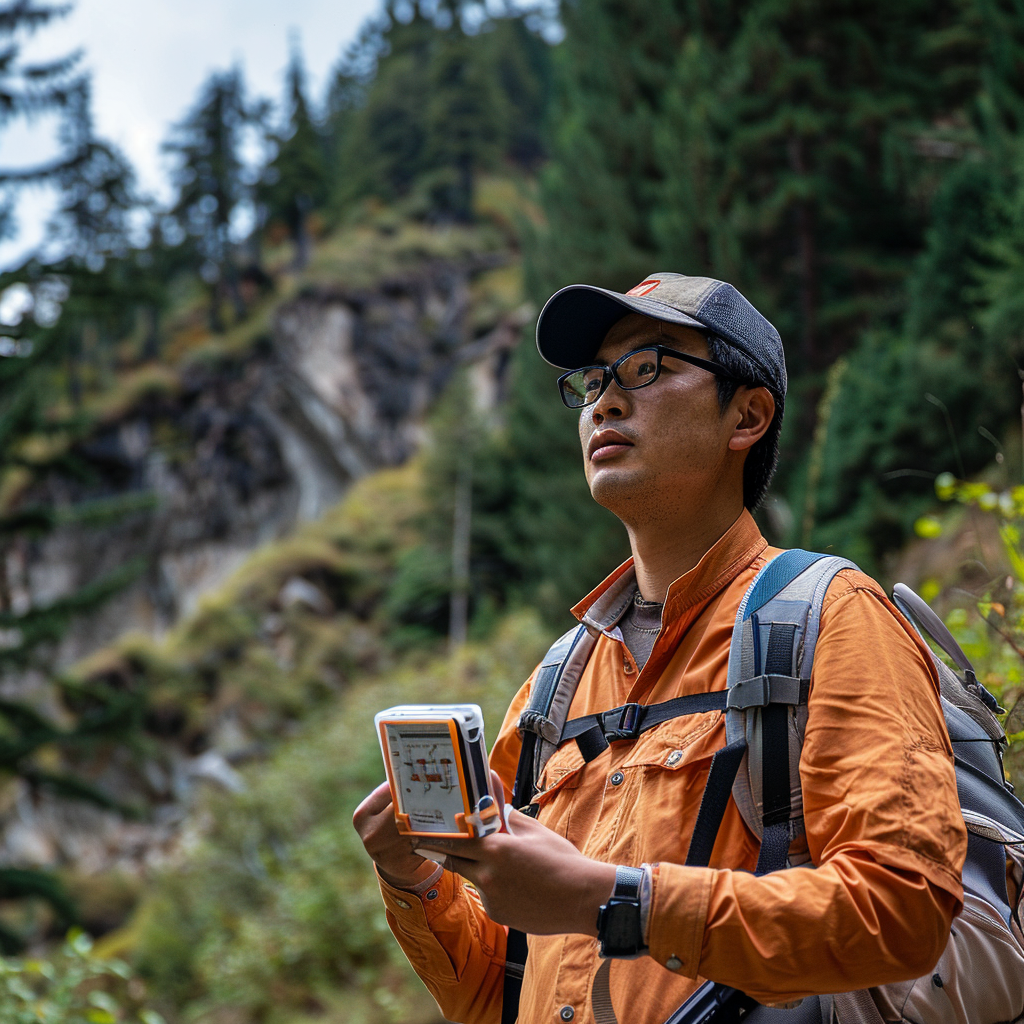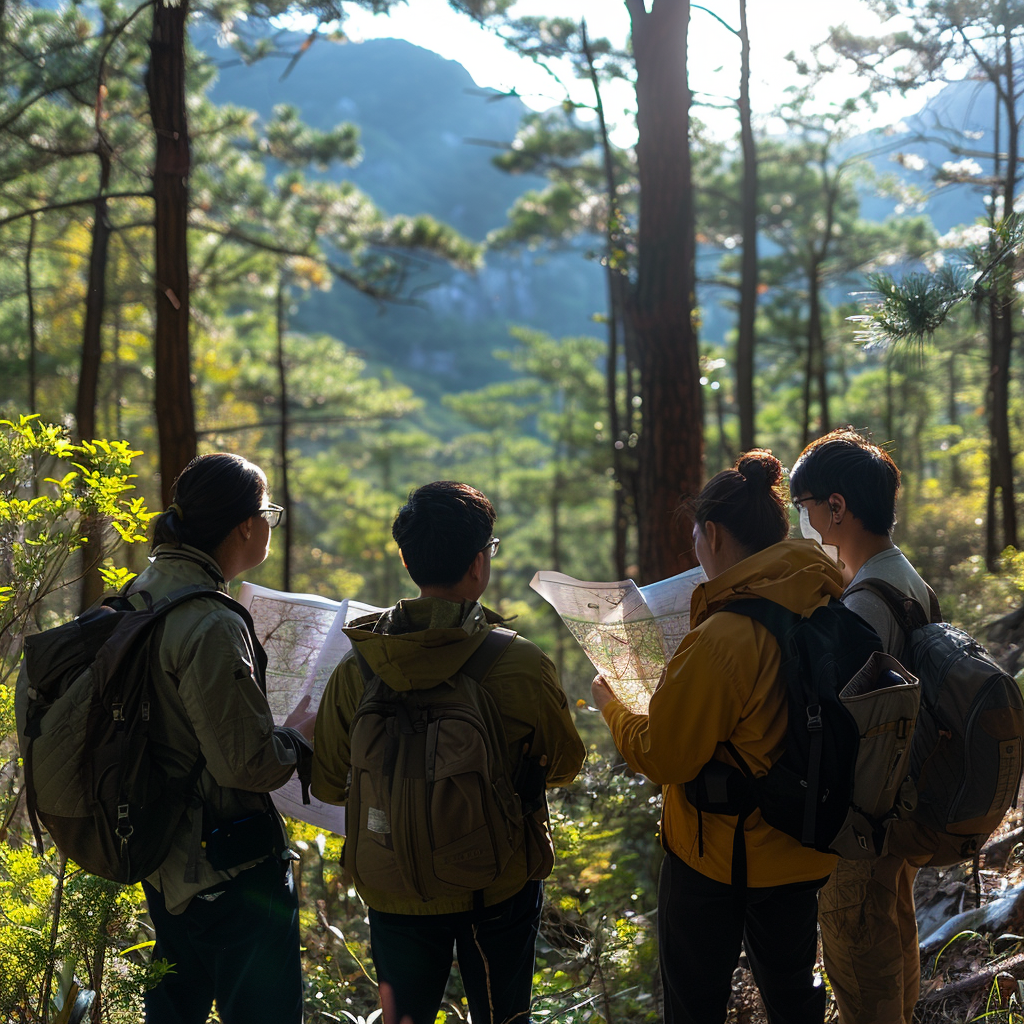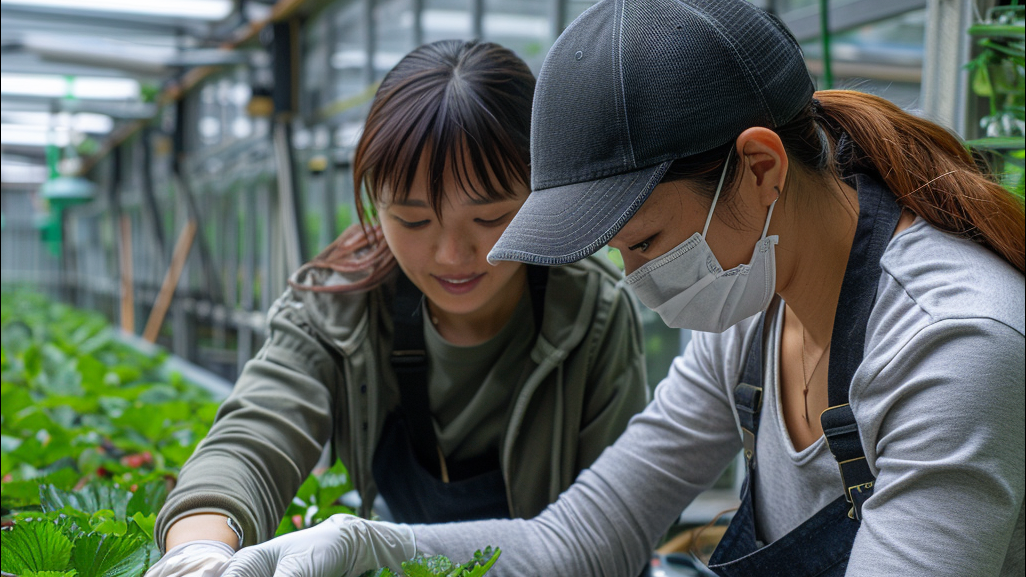发布:2025-10-17 浏览:0
森林资产评估是我国林草产业发展和规模化现代化经营的基础性工作,同时也是盘活森林资源、助力乡村振兴实现的重要途径油茶林在经营过程中具有投入大、周期长效果好、产品用途广等特点,是村民和集体经济组织中的重要资产。对油茶林的资产评估,有利于实现对油茶林的有效管理口,健全自然资源资产产权制度和管理制度中21,对促进科学化及现代化经营、村民就业增收建设乡村生态文明、维护国家粮油安全9推动绿色发展具有重要意义。
Forest asset assessment is a fundamental work for the development and large-scale modernization of China's forestry and grassland industry. It is also an important way to activate forest resources and help achieve rural revitalization. Oil tea forests have the characteristics of large investment, long cycle, good results, and wide product uses in the management process, and are important assets for villagers and collective economic organizations. The asset evaluation of oil tea forests is conducive to achieving effective management of oil tea forests, improving the property rights system and management system of natural resource assets, promoting scientific and modern management, increasing employment and income for villagers, building rural ecological civilization, maintaining national grain and oil security, and promoting green development.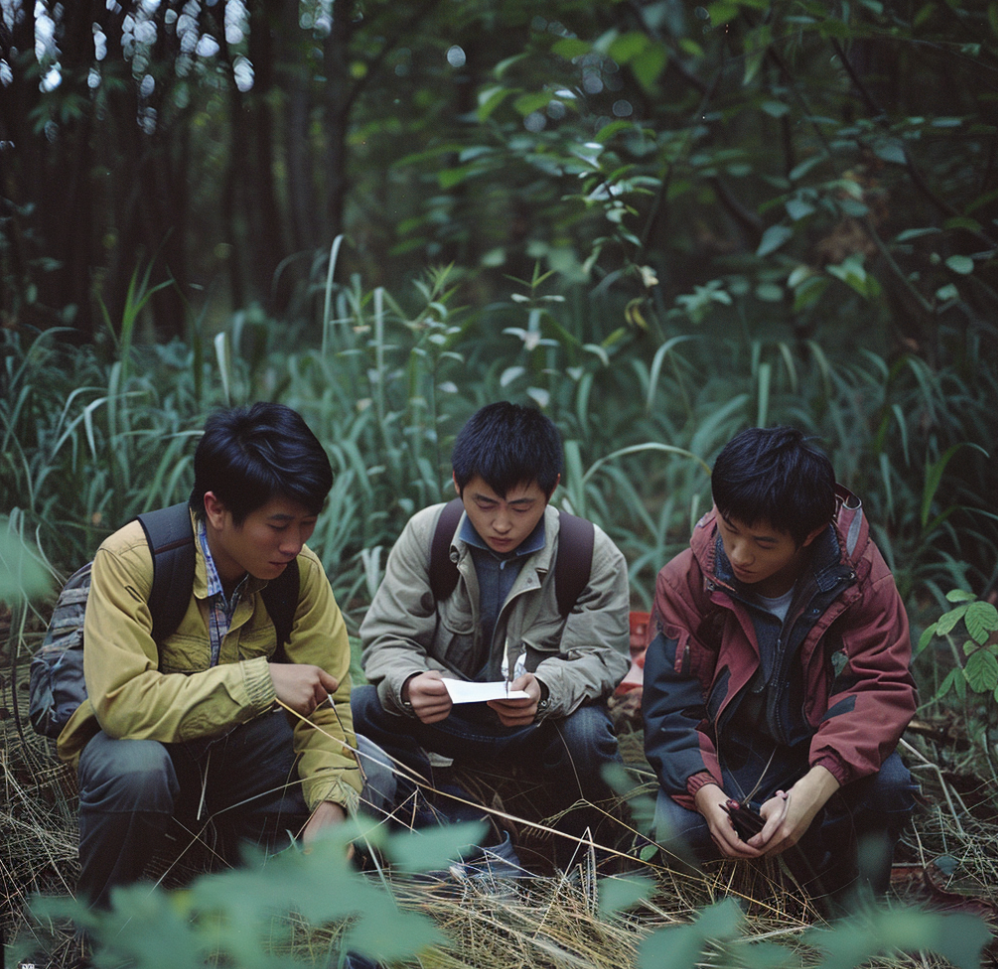
作为我国特有的木本食用油料树种,油茶主要分布于我国南方各省,其中湖南2023年油茶栽培面积、产量和产值均为全国第1为推动油茶等木本粮油产业可持续发展,2006年,国家林业局印发《关于发展油茶产业的意见》4-s1;2009年,国家发展和改革委员会繽太粳舒顙忧遥遛财润幔盗政部、国家林业局印发了《全国油茶产业发展规划(2009-2020年)》,把油茶产业发展列入国家食用油安全保障战略;2015年,国家林业局、财政部、国务院扶贫办国家开发银行联合发布《关于整合和统筹资金支持贫闲地区油茶核桃等木本油料产业发展的指导意见》,明确了中央财政资金重点支持种苗生产、基地建设、科技创新和技术推广等关键环节,并加大对油茶种植的补贴力度,新造林补助标准由2015年之前的4500元/hm增至7500元/hm:2022年,国家林业和草原局印发《林草产业发展规划(2021-2025年)》,提出到2025年木本油料种植面积达到1800万hm左右,木本食用油年产量达到250万:2023年,国家林业和原局、国家发展和改革委员会、财政部联合印发《加快油茶产业发展三年行动方案(2023-2025年)》,明确2023-2025年完成新增油茶种植127.8万hm'、改造低产林85.1万hm,确保到2025年全国油茶种植面积达到60钩ㄉ埋万hm以上、茶油产能达到200万t此外,2023年中央一号文件指出,要抓紧抓好粮食和重要农产品稳产保供,支持木本油料发展,实施加快油茶产业发展三年行动落实油茶扩种和低产低效林改造任务2024年中央一号文件再次提出,要扩大油菜面积,支持发展油茶等特色油料!
As a unique woody edible oil tree species in China, Camellia oleifera is mainly distributed in various provinces in southern China. In 2023, Hunan Province ranked first in the cultivation area, yield, and output value of Camellia oleifera in China. In order to promote the sustainable development of woody grain and oil industries such as Camellia oleifera, in 2006, the National Forestry Administration issued the "Opinions on the Development of Camellia oleifera Industry" (4-s1). In 2009, the National Development and Reform Commission and the National Forestry Administration issued the "National Camellia oleifera Industry Development Plan (2009-2010)", which included the development of the Camellia oleifera industry in the national edible oil safety guarantee strategy; In 2015, the State Forestry Administration, the Ministry of Finance, the State Council Poverty Alleviation Office, and the National Development Bank jointly issued the "Guiding Opinions on Integrating and Coordinating Funds to Support the Development of Woody Oil Industry such as Camellia oleifera and Walnut in Poor and Idle Areas", which clarified the key links of central financial support for seed production, base construction, scientific and technological innovation, and technology promotion, and increased subsidies for Camellia oleifera planting. The new afforestation subsidy standard increased from 4500 yuan/hm before 2015 to 7500 yuan/hm: In 2022, the State Forestry and Grassland Administration issued the "Forest and Grassland Industry Development Plan (2021-2025)", proposing that the woody oil planting area should reach 18 million hm by 2025 Around, the annual output of woody edible oil will reach 2.5 million. In 2023, the State Forestry and the former Bureau, the National Development and Reform Commission and the Ministry of Finance jointly issued the Three Year Action Plan for Accelerating the Development of the Camellia oleifera Industry (2023-2025), which specifies that 1.278 million hectares of new Camellia oleifera will be planted and 851000 hectares of low yield forests will be transformed in 2023-2025, so as to ensure that by 2025, the planting area of Camellia oleifera will reach more than 60 million hectares, and the tea oil production capacity will reach 2 million tons. In addition, the No. 1 central document of the Central Committee pointed out that we should pay close attention to ensuring the stable production and supply of grain and important agricultural products, support the development of woody oil plants, and accelerate the oil tea industry. The three-year development action is to implement the task of camellia oleifera seed expansion and transformation of low yield and low efficiency forests. In 2024, the No. 1 central document of the Central Government again proposed to expand the area of rape and support the development of camellia oleifera and other characteristic oils!
油茶林生长特性、经营措施及资产价值与一般用材林不同,不能照搬用材林林木资产评估方法,而应根据油茶林的特征采用科学的相应评估方法进行评估。本文将根据不同的立地条件、经营水平、品种及特性年輅挚序涛鋱親砀跬个N閻西鮎b婺等对油茶林评估方法进行操讨,并提出突出油茶林年龄价值的综合评估法,以助力餉鴝濼躁裣宅孑悱漚焱茶構鎢擁林经营模式创新,吸引更多社会资本投入油茶产业建设[9
The growth characteristics, management measures, and asset value of oil tea forests are different from those of general timber forests. Therefore, the evaluation methods for timber forest assets cannot be simply copied. Instead, scientific and corresponding evaluation methods should be adopted based on the characteristics of oil tea forests for evaluation. This article will discuss the evaluation methods of Camellia oleifera forests based on different site conditions, management levels, varieties, and characteristics, and propose a comprehensive evaluation method that highlights the age value of Camellia oleifera forests, in order to assist in the innovation of management models for the construction of the Camellia oleifera industry and attract more social capital investment
1.油茶林经营概况及评估需求
1. Overview and evaluation needs of oil tea forest management
我国是世界油茶的集中产地,栽培历史悠久。最适宜栽培区包括湖南、江西等8省(区),栽培区海拔一般在800m以下,其中500m以下土层深厚肥沃的丘岗山地生长最好。油茶树寿命长达百年,适应性抗逆性强作为一种常绿阔叶树种,不仅能绿化国土改良土壤,同时也具有较好的经济效益,可增加农民收人。采用油茶良种按照油茶丰产林栽培技术造林,3~4年后开花结果,7~8年鲜果产量可达1500kg/hm,10年后进人盛果期(可持续60年以上),可产鲜果7讞碴碗子5锼お聡劾0鄢k燁鰷剪g/hm'以上。受林权(含所有权、经营权及承包权)和传统经营思想影响,油茶目前主要有5种经营形式,即村组集体经营(原有老油茶林)、村民自主经营、大户承包经营、合作社经营和公司承包经营。近年来油茶产业发展较快,新造油茶林占现有油茶林面积的40%以上,受经营水平和近年来早灾等极端天气的影响,产量极不稳定,鲜果产量大多维持在750~1500kg/hm
China is a concentrated producer of oil tea in the world, with a long history of cultivation. The most suitable cultivation areas include 8 provinces (regions) such as Hunan and Jiangxi. The altitude of the cultivation area is generally below 800m, with the best growth occurring in hilly and mountainous areas with deep and fertile soil layers below 500m. Camellia oleifera has a lifespan of up to a hundred years and strong adaptability and stress resistance. As an evergreen broad-leaved tree species, it can not only green the land and improve the soil, but also have good economic benefits and increase farmers' income. Using high-quality Camellia oleifera seeds and following the cultivation techniques of Camellia oleifera high-yield forests, afforestation can result in flowering and fruiting after 3-4 years, with a fresh fruit yield of up to 1500kg/hm in 7-8 years. After 10 years, it enters the peak fruiting period (which can last for more than 60 years) and can produce 7 pieces of fresh fruit, 5 pieces of rice, and over 0 grams per hour. Influenced by forest rights (including ownership, management, and contracting rights) and traditional management ideas, there are currently five main forms of operation for oil tea, namely village collective operation (formerly old oil tea forests), village self operation, large-scale contracted operation, cooperative operation, and company contracted operation. In recent years, the oil tea industry has developed rapidly, with new oil tea forests accounting for more than 40% of the existing oil tea forest area. Due to the impact of management level and extreme weather conditions such as early disasters in recent years, the yield is extremely unstable, and the fresh fruit yield is mostly maintained at 750-1500kg/hm
油茶营造林投入大、周期长、效益低同嫀邮蜴鎗时厖搓嬋在受?排地条件、品种、经营水平、自然灾害、加工方法及市场等因素影响,产量极不稳定!0,导致部分油茶林经营者失去信心迫切需要财政投入或融资合作经营。因此油茶林资产评估应运而生,而对油茶林资产评估需求则体现以下几方面:一是现代化油茶产业体系发展的需求!1;二是规模经营的需求,如一些公司投资油茶产业,谋求做大做强:三是融资发展需求,如贷款、扩股等:四是林权纠纷调处的需求;五是林地征占用补偿及二次流转等需求。
Is the afforestation in the oil tea plantation affected by the high investment, long cycle, and low efficiency compared to the traditional Chinese medicine industry? The output is extremely unstable due to factors such as land conditions, varieties, management level, natural disasters, processing methods, and market! 0, causing some oil tea forest operators to lose confidence and urgently need financial investment or financing cooperation for operation. Therefore, the evaluation of oil tea forest assets has emerged, and the demand for oil tea forest asset evaluation is reflected in the following aspects: firstly, the demand for the development of a modern oil tea industry system! 1. The second is the demand for scale operation, such as some companies investing in the oil tea industry to seek growth and strength; the third is the demand for financing and development, such as loans, stock expansion, etc.; the fourth is the demand for resolving forest rights disputes; The fifth is the demand for compensation for forest land acquisition and occupation, as well as secondary circulation.
2.油茶林资产评估常规方法
2. Conventional methods for asset evaluation of oil tea forests
油茶林的资产评估是指专业评估人员依据林业法律法规和林业行业评估标准,对拟评估的油茶林资源资产进行现场调查、林分测量、统计汇总、价值估算、数据分析并发表专业意见的具体行为和工作过程1。油茶林资产评估是对其产品价格、生产经营成本经济寿命、年度产量和资金折现率等经济指标的评估,目的是实现对油茶林资产的有效利用,提升油茶林资产价值口。现有对油茶林资产的评估主要采用重置成本法、收益现值法、收获现值法、市场成交价比较法、剩余鈄抑抱扺显价緘谩皺忖挂?感螗匏曖饈痈鸡等5种方法:此外,湖南根据实际提出了资产评估标尺值法。
The asset evaluation of oil tea forests refers to the specific behavior and work process of professional evaluators conducting on-site investigations, forest stand measurements, statistical summaries, value estimation, data analysis, and expressing professional opinions on the oil tea forest resource assets to be evaluated based on forestry laws and regulations and forestry industry evaluation standards. Oil tea forest asset evaluation is the assessment of economic indicators such as product prices, production and operation costs, economic life, annual output, and capital discount rate, with the aim of achieving effective utilization of oil tea forest assets and enhancing their value. The current evaluation of oil tea forest assets mainly adopts the reset cost method, present value of income method, present value of harvest method, market transaction price comparison method, and residual hedging method? There are five methods for evaluating assets, including the use of sensitive, warm, and delicious foods. In addition, Hunan has proposed the asset valuation standard value method based on actual conditions.
1)重置成本法。该方法是按评估基准日的工价及作业水平重新造林及抚育管理一块与被评估的油茶林相同林分所需要的营造林成本费用吗,可分为产前期油茶林(1~8年)和篢初产期油茶林评估(9~15年)。其对每年投入与产出的数据要求准确详细,并按当錈盡飲圆棵年闘)未嗵价蓍麃侄计算。该方法实际评估应用较多便于操作、准确性高,适合新造油茶林。
1) Reset cost method. Is this method based on the evaluation benchmark date's labor price and operational level for reforestation and nurturing management of a forest branch that is the same as the evaluated oil tea forest? The afforestation cost can be divided into pre production oil tea forest (1-8 years) and early production oil tea forest evaluation (9-15 years). It requires accurate and detailed data on annual inputs and outputs, and calculates them based on the annual income of the whole plant. This method has many practical applications, is easy to operate, and has high accuracy, making it suitable for new oil tea plantations.
2)收益现值法。该方法适合处于8年以上的盛产期油茶林资产评估,其优点是数据翔实、准确直观,不足是档案数据资料难收集。该方法要求油茶林各年度收人与产出数据完整,相对而言其评估结果更准确可靠。
2) Present value of earnings method. This method is suitable for asset evaluation of oil tea forests that have been in high production for more than 8 years. Its advantages are that the data is detailed, accurate, and intuitive, but its disadvantage is that it is difficult to collect archival data. This method requires complete annual income and output data for the Camellia oleifera forest, making its evaluation results relatively more accurate and reliable.
3)收获现值法。该方法能够较为全面地反映油茶林的经济价值,适合盛产期油茶林,油茶林盛产期长达40~60年,期间油茶林鲜果产量高且相对稳定,林分抗逆性强、经济价值大、收益多。该方法要求各年度收人数据准确,评估结果直观;但计算比较复杂数据获取困难、市场价格影响波动大。
3) Harvest present value method. This method can comprehensively reflect the economic value of oil tea forests and is suitable for oil tea forests during their peak production period, which can last for 40-60 years. During this period, oil tea forests have high and relatively stable fresh fruit yields, strong forest resistance, high economic value, and high returns. This method requires accurate annual revenue data and intuitive evaluation results; But the calculations are complex, data acquisition is difficult, and market prices fluctuate greatly.
4)市场成交价比较法。该方法是将同年龄同立地条件的油茶林的现行市场成交价作为比较基础,依据该价格对拟评估的油茶林资源资产进行评估的方法。同一个评估对象需要选取3个以上案例,并就代表性、合法性、适宜性、准确性等方面进行分析,可采用算术平均法、加权平均法、综合分析法等方法计算,并在评估报告中说明采用的方法和理由。该方法适合所有油茶林评估,要求市场交易活跃、案例多,缺点是很难找到已成交的多个案例。
4) Market transaction price comparison method. This method uses the current market transaction price of oil tea forests of the same age and site conditions as a comparative basis, and evaluates the oil tea forest resource assets to be evaluated based on this price. The same evaluation object needs to select three or more cases and analyze their representativeness, legality, suitability, accuracy, and other aspects. Methods such as arithmetic mean, weighted mean, and comprehensive analysis can be used for calculation, and the methods and reasons used should be explained in the evaluation report. This method is suitable for evaluating all oil tea forests, requiring active market transactions and multiple cases. The disadvantage is that it is difficult to find multiple cases that have already been completed.
5)剩余价值法。该方法适合盛产期后的老油茶林评估。油茶林随着年龄增长、经营不善进人衰产期后,油茶林的产量和经济效益逐年下降,形成了投人大于产出的亏损局面。但油茶树寿命长,随着年龄增加,生态效益增强,可通过移栽、嫁接及生物质燃料原料采伐利用等增加油茶古树价值。其价值可采用剩余价值法根据实际应用情况评估,缺点是数据获取困难、油茶树价值开发不确定。
5) Surplus value method. This method is suitable for evaluating old oil tea forests after the peak production period. With the aging and poor management of oil tea forests, their output and economic benefits have been declining year by year, resulting in a loss situation where input exceeds output. But oil tea trees have a long lifespan, and as they age, their ecological benefits increase. The value of oil tea trees can be increased through transplanting, grafting, and harvesting of biomass fuel materials. Its value can be evaluated using the residual value method based on actual application situations, but the disadvantages are difficulty in obtaining data and uncertainty in developing the value of Camellia oleifera trees.
6)评估标尺值法。依据《森林资源资产评估技术规范》等相关要求,对建设期、初产期油茶林资产采用重置成本法进行评估对盛产期油茶林采用收获现值法分别计算委估油茶林资产的评估值,得出不同类型、不同年龄的油茶林单位面积资产评估标尺值。油茶分区主要按照单位面积前期投人、垦复造林标准和立地条件等不同分为一类区和二类区,如湖南长株潭为一类区、其他地区为二类区。一类区域油茶林的单位面积资产折算系数为1,二类区域油茶林的单位面积资产折算系数为0.85。估值人员可依据油茶林品质、密度、品种与平均投入等情况对评估结果适当进行上下浮动调整,初产期的新造林和建设期的低改林上下调整幅度不超过5%盛产期的油茶林上下调整幅度不超过10%即调整系数分别为0.95或0.90。委估油茶林评估值等于面积、该年龄评估标尺值、调整系数及折算系数的乘积。该方法适合所有油茶林的评估,实用性强、操作容易,湖南油茶林评估大多采用此方法:缺点是评估值与实际值相比偏大,结果依赖性与数据滞后性灵活性不足,且适应性较差。
6) Evaluate the ruler value method. According to the Technical Specifications for Forest Resource Asset Evaluation and other relevant requirements, the reset cost method is used to evaluate the assets of oil tea forests during the construction and initial production periods. The present value of harvest method is used to calculate the evaluation value of the oil tea forest assets during the abundant production period, and the evaluation scale values of oil tea forest assets per unit area for different types and ages are obtained. Oil tea zoning is mainly divided into Class I and Class II zones based on different standards such as pre investment per unit area, afforestation standards, and site conditions. For example, Changsha Zhuzhou Xiangtan in Hunan Province is classified as Class I zone, while other areas are classified as Class II zone. The conversion coefficient of assets per unit area for oil tea forests in Class I regions is 1, and the conversion coefficient of assets per unit area for oil tea forests in Class II regions is 0.85. Valuation personnel can adjust the evaluation results appropriately based on factors such as the quality, density, variety, and average input of the oil tea forest. The adjustment range for newly planted forests in the initial production period and low converted forests in the construction period should not exceed 5%, and the adjustment range for oil tea forests in the high-yield period should not exceed 10%, with adjustment coefficients of 0.95 or 0.90, respectively. The assessed value of the oil tea forest is equal to the product of the area, the age assessment scale value, the adjustment coefficient, and the conversion coefficient. This method is suitable for the evaluation of all Camellia oleifera forests, with strong practicality and easy operation. This method is mostly used for the evaluation of Camellia oleifera forests in Hunan. The disadvantage is that the evaluation value is relatively large compared to the actual value, the result dependence and data lag flexibility are insufficient, and the adaptability is poor.
3.油茶林资产综合评估法
3. Comprehensive evaluation method for oil tea forest assets
相对于其他的用材林,油茶林的资产评估因其不同的生长特性和经营措施、培育目标,应有不同的资产评估方法。选择对应的资产评估方法,有利于提升评估准确性。由于缺乏油茶产量数据,目前的评估大多采用本地高产油茶林产量数据或理论设计产量数据,评估结果可信度低,与实际产量存在较大差异。油茶特性包括品种多、地域广、大小年明显、产量不稳定等,特别是笔者自2008年开展油茶林评估实践及常宁市油茶测产工作以来发现,新造油茶林茶果产量随着年龄的增长而增加。根据这一规律,本文提出了综合评估法,即按经营期分段计算评估值的方法。
Compared to other timber forests, the asset evaluation of oil tea forests should have different methods due to their different growth characteristics, management measures, and cultivation goals. Choosing the corresponding asset evaluation method is beneficial for improving the accuracy of the evaluation. Due to the lack of oil tea production data, most current evaluations use local high-yield oil tea forest production data or theoretical design production data, resulting in low credibility of evaluation results and significant differences from actual production. The characteristics of Camellia oleifera include a wide variety of varieties, a wide geographical area, significant differences in size and year, and unstable yield. In particular, since the author conducted the evaluation practice of Camellia oleifera forests and the production measurement of Camellia oleifera in Changning City in 2008, it has been found that the tea fruit yield of newly constructed Camellia oleifera forests increases with age. Based on this law, this article proposes a comprehensive evaluation method, which calculates the evaluation value in segments according to the operating period.
1)划分生长周期和时期。对油茶林依据其生长、生产和经营特点的不同来划分生长周期。新造油茶丰产林生长周期一般分4个时期,即建设期(未成林造林期,通常1~3年)、初产期(4~7年)、盛产期(8~60年)、衰产期(60年以后);老油茶林可分为常规油茶林和低改油茶林。改造后的油茶林生长周期分为2个时期,即建设期(进行低改后1-4年的油茶林)、盛产期(进行低改后5-20年内的油茶林)。针对拟估油茶林年龄根据油茶林年龄、类型区分不同的生长周期如拟估对象为20年的油茶林,可区分为3个时期,即建设期3年、初产期4年、盛产期13年。
1) Divide growth cycles and periods. Divide the growth cycle of oil tea forests based on their different growth, production, and management characteristics. The growth cycle of newly developed oil tea high-yield forests is generally divided into four stages, namely the construction period (pre afforestation period, usually 1-3 years), the initial production period (4-7 years), the abundant production period (8-60 years), and the decline period (after 60 years); Old oil tea forests can be divided into conventional oil tea forests and low modified oil tea forests. The growth cycle of the renovated Camellia oleifera forest is divided into two periods, namely the construction period (1-4 years after the transformation) and the peak production period (5-20 years after the transformation). According to the age and type of the oil tea forest to be estimated, different growth cycles can be distinguished. For example, if the estimated object is a 20-year-old oil tea forest, it can be divided into three periods: a construction period of 3 years, an initial production period of 4 years, and a peak production period of 13 years.
2)计算各生长周期时期末单位面积的评估值。选定各时期末的评估方法,计算拟估油茶林各时期末的评估值,如建设期、初产期可选用重置成本法或评估标尺值法计算盛产期可采用收获现值法等。以周期末日期为评估基准日,即对应时期末年的12月31日为该生长时期末评估基准日。
2) Calculate the evaluation value per unit area at the end of each growth cycle period. Select the evaluation method at the end of each period and calculate the evaluation value of the proposed Camellia oleifera forest at the end of each period. For example, during the construction period and initial production period, the reset cost method or the evaluation scale value method can be used to calculate the peak production period, and the present value of harvest method can be used. Using the end date of the cycle as the evaluation reference date, that is, December 31st at the end of the corresponding period as the evaluation reference date for the end of the growth period.
3)计算生长周期各生长时期权重值。在评估中把油茶林龄列入评估权重指标,以生长周期各时期年龄数值除以拟估油茶林年龄作为权重值。例如,拟评估油茶林龄20年其建设期3年,则权重值为3/20:初产期4年,权重值为4/20;盛产期13年,权重值13/20
3) Calculate the weight values of each growth period in the growth cycle. In the evaluation, the age of the Camellia oleifera forest is included as a weight indicator, and the weight value is calculated by dividing the age values of each stage of the growth cycle by the estimated age of the Camellia oleifera forest. For example, if the age of the oil tea forest is 20 years and its construction period is 3 years, the weight value is 3/20; if the initial production period is 4 years, the weight value is 4/20; The peak production period is 13 years, with a weight value of 13/20
4)计算拟估油茶林评估值。依据生长周期各时期末计算的单位面积评估值,加权计算得到评估基准日单位面积的评估值,再计算拟评估面积评估值,见公式
4) Calculate the estimated value of the oil tea forest. Based on the unit area evaluation values calculated at the end of each growth cycle period, the weighted calculation is used to obtain the evaluation value of the unit area on the evaluation reference date, and then the evaluation value of the proposed evaluation area is calculated, as shown in the formula
对市场进行调查并分析论证中4,以获得符合客观实际的评估结果9。同时,茶油产品及肥料等农资产品市场价格波动大,受劳动力市场价格等因素的影响,油茶林评估有待进一步研究。(1):
Conduct market research and analysis to obtain objective and realistic evaluation results. At the same time, the market prices of tea oil products and agricultural inputs such as fertilizers fluctuate greatly, and are influenced by factors such as labor market prices. Therefore, further research is needed for the evaluation of oil tea forests. (1):
式中,E为拟估油茶林评估值,X为拟评估油茶林资产的面积(单位为hm'),为生长周期中第:个时期末评估值,i为生长时期,)为生长周期中时期个数,d;为生长周期中第个时期年数,"为林分年龄。采用单位面积资产评估标尺值法评估20年的油茶林评估值为90877.5元/hm':采用重置成本法计算,20年的油茶林评估值为79650元/hm:而采用综合评估法计算,评估值为86324.32元/hm。3种评估方法的平均评估值为85617.3元/hm’,与综合评估法测算的评估值更接近。
In the formula, E is the estimated value of the oil tea forest, X is the area of the oil tea forest assets to be evaluated (unit: hm '), is the evaluation value at the end of the th period in the growth cycle, i is the growth period,) is the number of periods in the growth cycle, d; is the number of years in the th period of the growth cycle, "is the age of the forest. The evaluation value of the oil tea forest for 20 years using the unit area asset evaluation scale method is 90877.5 yuan/hm', calculated using the reset cost method, the evaluation value of the oil tea forest for 20 years is 79650 yuan/hm, and calculated using the comprehensive evaluation method, the evaluation value is 86324.32 yuan/hm. The average evaluation value of the three evaluation methods is 856.36 yuan/hm. 17.3 yuan/hm ', which is closer to the evaluation value calculated by the comprehensive evaluation method.
综合评估法按生长周期分时期计算评估值,适合于所有油茶林评估,并充分考虑了油茶林特性和规律,体现了油茶林年龄价值规律,提升了油茶林评估水准。与其他评估方法不同之处在于:一是体现了油茶林随生长年龄增加而产量递增规律,二是打破了传统一片林用单一评估方法评估的做法。综合评估法优势在于接近实际值,交易双方易于接受和认可;其不足表现在资料收集要完整年龄应准确,计算较复杂。
The comprehensive evaluation method calculates evaluation values in stages according to the growth cycle, which is suitable for evaluating all oil tea forests and fully considers the characteristics and laws of oil tea forests. It reflects the age value law of oil tea forests and improves the evaluation level of oil tea forests. The difference from other evaluation methods lies in: firstly, it reflects the law of increasing yield of Camellia oleifera forest with increasing growth age; secondly, it breaks the traditional practice of evaluating a single forest using a single evaluation method. The advantage of the comprehensive evaluation method lies in its proximity to actual values, which are easily accepted and recognized by both parties in the transaction; Its shortcomings are manifested in the need for complete data collection, accurate age, and complex calculations.
4.结束语
4. Conclusion
油茶林年龄是影响评估值的重要因素常常被忽视。本文将林龄列入评估值权重计算樞蚩子笑,更ト符合油茶林生长、经营及价值增长规律。油茶林资产评估值是其油茶鲜果价格、年度鲜皚握果产量、生产经营投入成本、资金折现利率和经济寿命期等综合作用的结果。在技术参数确定时,要结合油茶林的实际情况.
The age of oil tea plantations is often overlooked as an important factor affecting the evaluation value. This article includes Lin Ling in the weight calculation of the evaluation value, which is more in line with the growth, management, and value growth laws of oil tea forests. The asset evaluation value of oil tea forest is the result of the comprehensive effects of its oil tea fresh fruit price, annual fresh fruit yield, production and operation input cost, discounted interest rate of funds, and economic life cycle. When determining technical parameters, it is necessary to take into account the actual situation of the oil tea forest
本文由 林业资产价格评估 友情奉献.更多有关的知识请点击 http://www.jyslpg.com/ 真诚的态度.为您提供为全面的服务.更多有关的知识我们将会陆续向大家奉献.敬请期待.
This article is dedicated to the evaluation of forestry asset prices For more related knowledge, please click http://www.jyslpg.com/ Sincere attitude To provide you with comprehensive services We will gradually contribute more relevant knowledge to everyone Coming soon.
